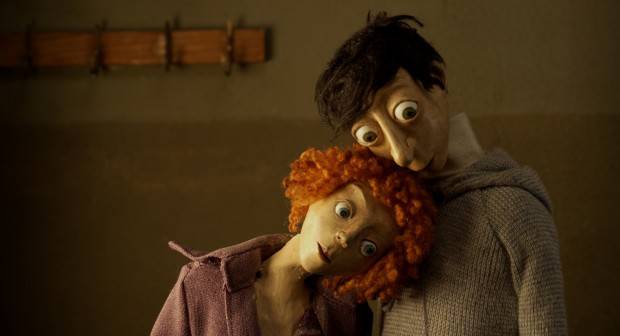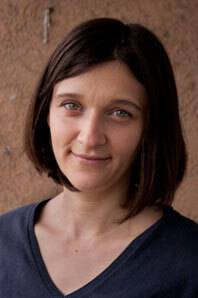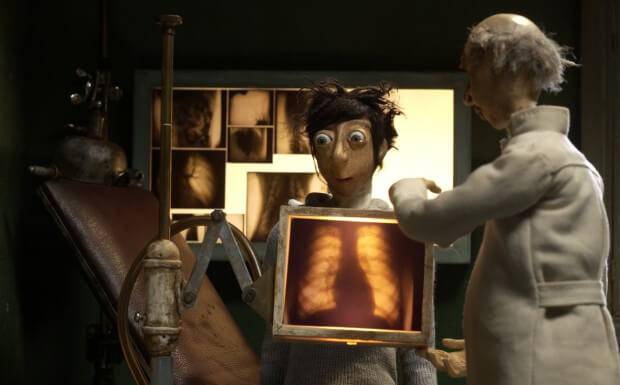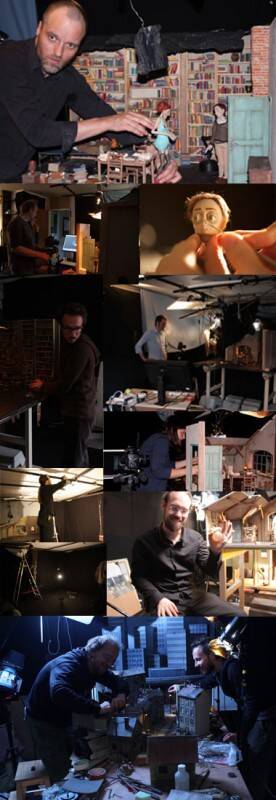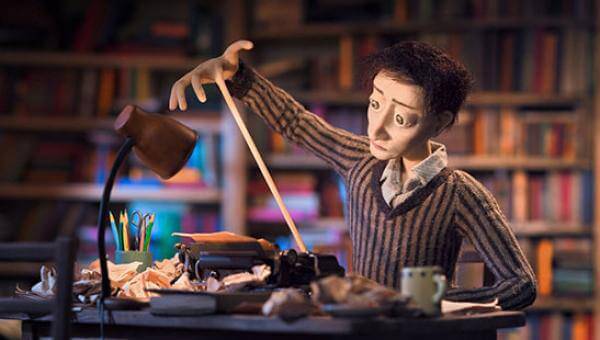Interview with ‘Boles’ director Špela Čadež
UPDATE: With its hugely successful festival run now concluded, Špela Čadež’s Boles saw its online premiere this week and can now be watched in full:
Slovenia-based animator Špela Čadež has been working in animation since graduating from the Academy of Media arts in Cologne, Germany in 2002. Since then her short films including Zasukanec (Mate to Measure) and Lovesick have been screened at hundreds of festivals across the world. The unique, dollhouse-like quality to her puppets echo her upbringing in Eastern Europe with their tactile, hand-crafted aesthetic.
Her most recent film Boles looks at loneliness and the creative process, the two intriguing characters both desperately trying to imagine different lives for themselves. The film is full of beautifully choreographed shots and wonderfully constructed, surreal scenarios whose attention to detail shows a progression in Čadež’s work. Skwigly had the opportunity to discuss her career and Boles in more detail, read below to find out about the film, the woman and much more:
Can you tell us a little about growing up in Slovenia and how that affected your decision to work in the field of animation?
I grew up in Yugoslavia where kids’ TV programs were composed mostly of Eastern European animations. We could watch only one or two per day, and some more on Sunday morning. Those were very strong impulses for all of us, although I am not sure if that was the real reason for me to start working in the field of animation. I studied graphic design here in Slovenia and continued my studies in Germany, where I first thought I’d work in the field of interactive design. By coincidence I then took part in a puppet animation workshop and never went back to the design department.
You graduated in 2002 in Ljubljana in Visual Communication Design. In what ways did these studies help you in producing your films and creative work?
I learned a lot of basics there. The program was very traditional. We had hand-drawn colour studies – drawing, painting, sculpturing – all of which were a great base for further work.
The first film of yours I saw – at a small animation festival in Poland called Stoptrick – was Lovesick. I really enjoyed your entwining of metaphors with narrative and seeing these turns of phrase visualised. Was the film inspired by events or in your own life or did it just seem like a fun idea?
That film was based on my dreams. I was the one whose heart was cut out and brought to the lab, but it slipped on the floor and was all dirty. And as dreams always are, they were also very much influenced by my life. I believe if you make an animation, the subject you choose should be close to you as you will spend a lot of time on it.
Can you tell us a little about the original short story that the film Boles originates from – why did you choose this story and what, if anything, did you change?
The story is based on Maxim Gorky’s Her Lover. I always wanted to make a movie that is based on literature. I was searching for the right story for a long time, but when I read this story I immediately knew that was the story I wanted to adopt. Later on I realized that was a harder task than I thought. I had a long way searching for funding, so I had time to rewrite the story over and over again. I tried to find a way to use animation as the material carrying the story. So in the end I changed the story a great deal, but hopefully I still managed to stick with the underlying message.
The models in Boles had some unusual morphs and changes in both scale and movement, can you tell us a bit about how they were fabricated?
In this film I used dialogue for the first time. For the puppets to be able to speak we chose silicone as the main material. The material also seemed perfect for the event with wobbly fingers; It was surprisingly stretchy and it didn’t fall apart as we first thought it would. We had three different lengths of fingers, some with wire in, some without. The longest fingers were about 30 cm long. Making them was a great challenge for the puppet maker Žiga Lebar. This project was his first stop-motion work and on top of that we both worked for the first time with silicone. We learned everything from internet forums, blogs and friendly tips. The part Žiga spent most time on was the small typewriter. It’s only 4cm big and has a unique system to move the letters so the animation is indeed real. The big typewriter was done very fast, as he comes from puppet theatre and is thus more skilled in the slightly bigger scale.
This film really demonstrates what stop-motion can do, with surreal visuals integrated seamlessly into otherwise naturalistic scenes. What is it about stop-motion that draws you to this way of working?
I simply enjoy the whole process. I love stop motion, because it gives me such a wide panel of different work areas and endless creative possibilities. Jumping from one art field to another inspires me a great deal and I always try to find a way to support the story with the material I am using. My professor once said you should have a good reason for choosing animation for your story since it will take you so much more time and effort than a live-action movie.
How long did it take to develop and create this film?
The production process lasted about two years. Preproduction and searching for funding took two years also.
Where did you gain your funding for this film, was it an easy process?
This was my first film after my studies. It was a painful and stressful job; Starting from scratch is very hard. I chose to produce this film on my own, with great help from my friend Tina Smrekar. But it was all new for us, so it was also a learning process and it still is now in the distribution part. In the end the film was supported mainly by Slovenian Film Centre and, in smaller part, from Germany by Film und Medienstiftung NRW. More than half of my team was German since I worked so well with them on my graduation film Lovesick.
From a directorial perspective what was your main objective in working on this film?
The film as whole. I try not to use animation for the sheer fact that you can show what great things can be done with animation but rather to offer the viewers a film where they might forget they’re even looking at animation, because it comes so naturally with the story. It is an honor when you get such a remark back, especially when it is from a (live-action) film director, which is what happened to me a few weeks’ back. I am also very proud of the recent Best Short Film Award Boles received at the Slovenian Film Festival because it swept away many skeptical remarks and gave animation film as a whole the place it deserves – which is that it is primarily a film. So I would say my goal is to tell a story from the first moment on and to try to grasp the audience emotionally with the story.
The cinematography in the film is wonderful. How important was the overall look of the film to you?
For me the cinematography is very important, since it accents the detailed puppetry and scenography and it actually builds the whole atmosphere of the film. We spent a lot of time on it with the exceptional cinematographer Michael Jörg from Cologne. He worked on my graduation film as well and he already knew the scale he had to deal with. The hardest part was that we were shooting in Slovenia and he was in Germany. As we could only afford for him to come to the shooting three times we had to find another solution to communicate with him, we had video conferences quite often. For the camera and lighting continuity, credit goes also to the animators Oliver Throm and Leon Vidmar. They were both struggling with the lights and camera to get the best result before each scene.
Who did you empathise with most in the film, Fillip or Tereza?
In this film I had a chance to work with a professional animator. Before I mostly animated my films on my own. In Boles I worked with the fantastic animator Oliver Throm from Hamburg. For me it was a new challenge to be able to explain what I want before the scene is shot since you can’t change much later on, as is the nature of stop motion. I had more empathy with Filip, Oliver on the contrary could connect much better with Tereza. So you could say in the end they got it equally.
Boles was screened at Annecy and Brazilian festival Anima Mundi earlier this year and it will be screened at this year’s BAF in the Professional 1 selection. If you are able to make the festival we at Skwigly urge you to see this beautifully put together stop-motion short.
For more information on the work of Špela Čadež visit her website at spelacadez.com


